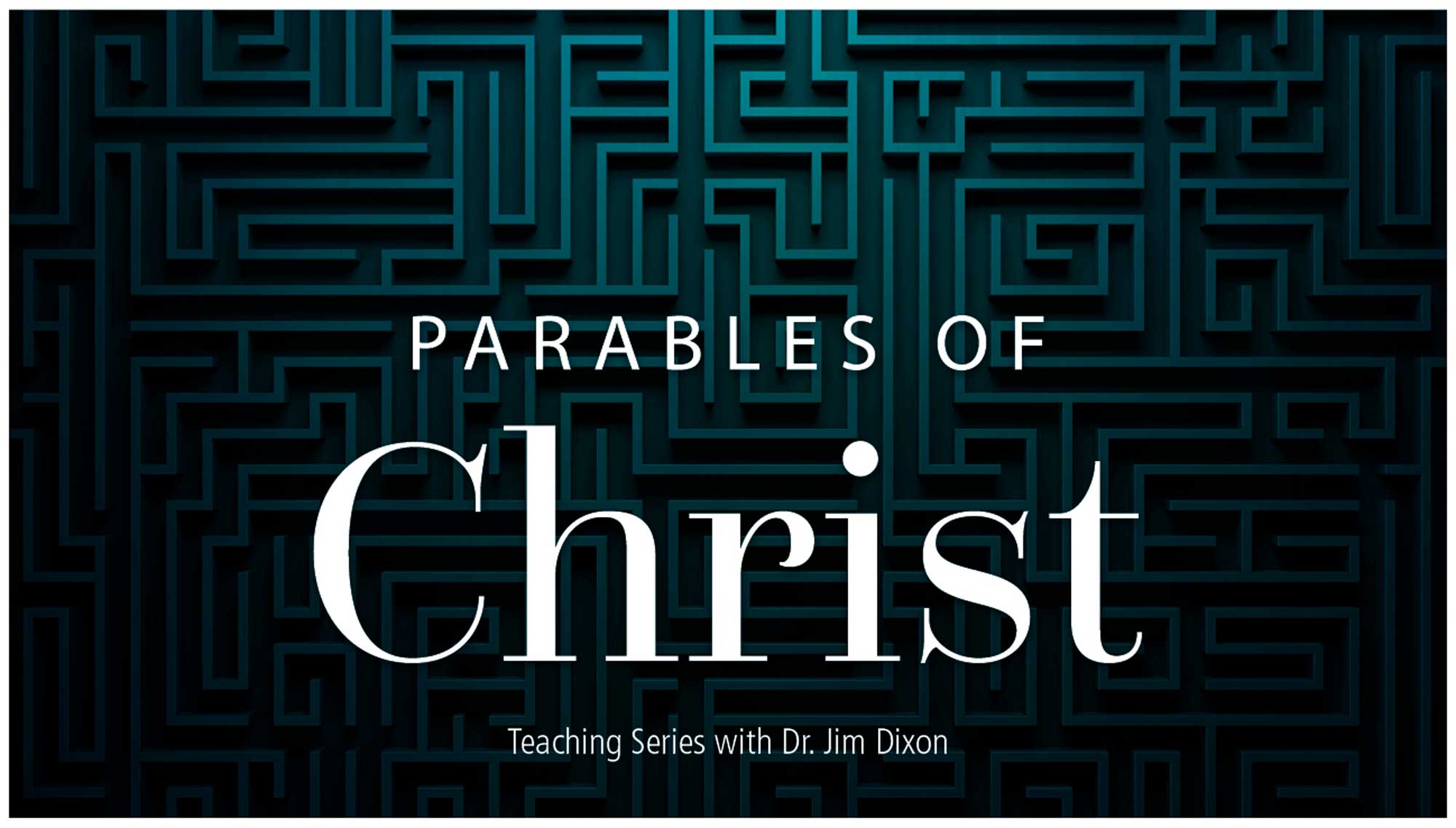PARABLES OF CHRIST
THE TEN MAIDENS
DR. JIM DIXON
MATTHEW 25:1-13
JUNE 14, 1998
In Jewish weddings, there were really three stages. First there was the engagement. And the engagement was arranged by the parents. More specifically, in that patriarchal culture in society, it was arranged by the fathers. The father chose his son’s bride, and the father chose his daughter’s groom. Most fathers did this lovingly. Most fathers did this thoughtfully and prayerfully. Most fathers consulted with their wives and consulted with their children. Sometimes the engagement took place when the children were very young. But then there came the betrothal, and the betrothal was when the engaged couple said their vows to each other and gave gifts to each other. But they were still not allowed to live together as husband and wife. They had to wait for a minimum of one year. After that year, the bridegroom came from his home. He came to the home of his bride. He came for his bride. He came for his bride’s family. He came for the entire bridal party including the bridesmaids and then he led them back to his home in a joyful processional. When they arrived at the bridegroom’s home there was a great feast, and the marriage was consummated.
This is the setting for this parable of The Ten Maidens. From this parable we have two teachings. The first teaching is a message of hope. The Bridegroom is coming. The Bridegroom is coming. The word for bridegroom in the New Testament is the Greek word “numphios.” This word is used fourteen times in the New Testament and generally in reference to the Son of God, our Lord Jesus Christ. He is the Bridegroom and He will one day come for the bridal party. He will one day come for His church.
The Apostle Paul, in 1 Thessalonians, chapter 4, writes, “The Lord Himself shall descend from heaven with a cry of command, with the archangel’s call, with the sound of the trumpet of God and the dead in Christ shall rise and we who are alive, who are left until His coming, shall be gathered together with them in the clouds to meet the Lord in the air and we shall always be with the Lord.” You see, He shall come from His home, the Bridegroom, and He will come for the bridal party.
He will not only come to receive His people, but I think most of you know that He will also come to judge the world. That is why the Apostle John writes in the book of Revelation, “Behold, He is coming with the clouds and every eye shall see Him. Everyone who pierced Him and all the nations of the earth will cry out on account of Him.” That is why our Lord Jesus said, “Behold I am coming soon, bringing My recompense to repay everyone for what they have done. I am the Alpha and Omega. I am the Beginning and the End.” Jesus Christ, the Bridegroom, will come.
There are three words in the Bible used to describe the second coming of Jesus Christ, three very important Greek words. The first word is “parousia.” This word means “presence,” or it means “coming.” This was a word that was specifically used in the Greek world of royal visitations. The word parousia described the coming of a king before his people. When a king came to a city to present himself before His people, that was called a parousia. This word perfectly applies to the second coming of Jesus Christ because He is King of Kings. The Bridegroom is the King and, as Christians, we await the King.
The second Greek word that is used for the second coming of Christ is the word “epiphaneia.” The word epiphaneia means “the appearing.” This word is precious to us as Christians. There’s no one in this worship center today who has seen Jesus face-to-face, no one. The Bible says in the book of Hebrews that “faith is the assurance of things hoped for and the conviction of things not seen.”
The Apostle Paul writes, “We await the appearing, the epiphaneia, of our great God and Savior Jesus Christ.” The Apostle John writes, “Beloved, we are children of God now. It does not yet appear what we shall be, but this much we know. When He appears, epiphaneia, we will be like Him. For we shall see Him as He is.” The appearing. The epiphaneia.
The third Greek word used for the second coming of Christ is the word “akatakaluptos.” This is the most powerful of the three words. The akatakaluptos literally means “the unveiling.” We understand, don’t we, that when Jesus Christ came to earth the first time, He was veiled. When He came the first time, His deity, His majesty, His glory was veiled, and the world saw a carpenter’s son. The world saw the son of Joseph and Mary. The world saw perhaps a great teacher, but they did not see His glory. There were moments of unveiling. When He calmed the sea and rebuked the wind and the people said, “Who is this that even the wind and the sea obey Him?” Moments of unveiling. When He raised from the dead the daughter of Jairus, when He raised from the dead the widow’s son in the village of Nain, when He raised from the dead Lazarus, the brother of Mary and Martha, those were moments of unveiling.
There was a moment of unveiling when He was transfigured on the holy mountain in the presence of Peter, James, and John. There were moments of unveiling, but when He comes again, when the Bridegroom comes, He will be unveiled for the entire world to see and they will see His glory. They will see His majesty.
On December 8, 1941, the Japanese attacked the Philippine Islands. The Islands were defended by the Filipinos. They were joined in defending those islands by the Americans. The Filipinos and the Americans were led by General Douglas MacArthur. Together they made a courageous stand on the Bataan Peninsula for 3-1/2 months. Then, in March of 1942, President Franklin Roosevelt commanded MacArthur to leave the Philippine Islands and to go to Australia where he was to become the Supreme Commander of the Allied Forces in the Southwest Pacific. MacArthur was airlifted from Corregidor but he did not want to leave the Philippines. He did not want to leave the Philippines because he knew that the Filipinos were under siege, and he knew that they were greatly outnumbered by the enemy. And he made that famous promise, “I shall return.” The people of the Philippines waited. They were captured, incarcerated, but they waited. It was autumn of 1944 when MacArthur returned with great forces and with great power. And it’s a matter of historical record that he set the people free.
Jesus Christ left our world and He knew that His people were under siege. He knew that His people were greatly outnumbered by the enemy. He knew this but He gave a promise. He said, “I will return.” And as His people we wait. And one day He will come, the Bridegroom for His true bride, for the entire bridal party, and He will take us home and He will judge the world.
A second teaching from this little parable is a message of perseverance and a call to faithfulness. The second teaching is this: No one knows the day or the hour. The Bridegroom is coming but no one knows the day or the hour. This is the statement Jesus concludes with when giving this parable. Nobody knows the day or the hour. Some of the maidens, some of the bridesmaids, were ready. Some were not ready. Be ready.
Throughout history there are many tragic examples of the church of Christ trying to predict the day and the hour. There are many tragic examples of Christian communities which believed that the coming of Christ was imminent and did improper things. In the first century, around the year 50 AD, Christians in Thessalonica quit their jobs to await the second coming of Christ and the Apostle Paul rebuked them. He told them to go back to work.
In the second century there arose a Christian leader, a prophet whose name was Montanus. He gathered a great following. He was joined in leadership by two women, a woman named Priscilla and a woman named Maximillia. Together they led their followers to two cities in Phrygia which is in modern-day Turkey, there to await the second coming of Christ. Montanus promised that he received this knowledge of the second coming of Christ by prophetic utterance. And so the people waited and the years passed and Maximillia died and then Priscilla died. Finally, Montanus died and the peoples’ hopes were dashed.
In the fifth century, Aryan vandals surrounded the city of Rome. Roman citizens were literally left to starve in the streets. This they did by the thousands. It’s a matter of historical record that in that primitive time and in that primitive culture, some of those Roman men and women actually ate their young. As Gothic hordes surrounded the eternal city, followers of the theologian Pelagius announced the end of the world, the consummation of the age, the immediate return of Jesus Christ. But, of course, it did not happen.
In the year 991, Vesuvius erupted. And in that same year, St. Peter’s Basilica burned to the ground. In 996, just a few years later, civil war erupted in the city of Rome. All these things were seen as birth pains that were leading to the new millennium. As the year 1,000 approached, there was millennial madness in Europe. Just before the year 1,000, as Otto III ascended the throne of the Holy Roman Empire, the Roman Catholic Church proclaimed the end of this age, the dawning of the new millennium, the millennial kingdom and the immediate return of Christ. But, of course, it did not happen.
In the year 1191, a prophet (at least a wannabe prophet), a mystic and a philosopher named Joachim told Richard the Lionhearted that Saladin, the famous Muslim sultan, was the Antichrist. He said that the crusades would ultimately lead to the battle of Armageddon, the consummation of the age, and the second coming of Jesus Christ. But, of course, it did not happen.
Just before the year 1500, about the time that Columbus arrived in the new world and about the time that Michelangelo was creating his great works of art, there arose a prophet whose name was Savanarola. He made many prophecies, some of which came true, but he made one fatal mistake. He predicted the second coming of Jesus Christ and he set the day and the hour and it did not happen.
I think many of you know that in the 19th century there arose William Miller, a New York State preacher. He was very charismatic, and he was followed by thousands of people. He proclaimed the second coming of Jesus Christ. He said it would happen October 22, 1844. As that date approached, 50,000 Millerites, sometimes called Adventists, quit their jobs to await the second coming of Christ. Some of them put on white robes and went to the tops of mountains. Some of them perched in trees. Some went into chapels or sanctuaries to await the coming of Christ. Of course, October 22, 1844, came and Jesus Christ did not. On October 23, 50,000 Millerites returned to their communities in embarrassment.
Christian history is filled with stories like these, tragically so. I promise you as the year 2,000 approaches, millennial madness will break forth once again. In fact, it’s already happening. Of course, there will come a final generation, a generation that sees the second coming of Jesus Christ. The Bible tells us that that generation will see certain signs. It is true that some of the biblical signs are being fulfilled in our time. It is true that Israel was reborn as a nation in 1948 and the Jewish people reoccupied the city of Jerusalem in 1967 and these things were prophesied. It is true that there is growing apostasy in the visible church and that this was prophesied. It is true that there is a breakdown of Judeo-Christian values in the western world and it is true that these things were prophesied.
Certainly there are some signs that we might be the final generation. Certainly there has been a proliferation of knowledge in our time. Knowledge has increased almost exponentially since the industrial revolution and this is said, in the Bible, to characterize the end times. Certainly it is true that the earth has been polluted in our time and the Bible prophesies that in the end times, at least one-third of the fresh water, the salt water, soil, and air will be polluted on the earth. That was true of no prior time. But, you see, it is not good to set the day or the hour. The reality is, biblically, that whenever Christ comes back, the important thing is we’re ready. This is the call to the church of Christ in every generation that we are ready, that we are prepared.
That’s why Jesus said, “Watch, therefore, for you know neither the day or the hour.” That’s what the point of the Ten Maidens is all about. It does not mean to scan the horizon. It means to awake. The word “diegeiro” means “to awake and prepare,” “awake and be ready.” And so, when Christ comes, will you be ready? If you love Him, if you’ve committed your life to Him, if you’ve received Him as Savior and Lord, that’s the beginning of readiness. Then if you would really be ready, you need to walk the walk, spend time in the Word. We need to spend time every day in the word, time every day in prayer. We need to spend regular time in community and fellowship with other Christians and we need to spend time involved in ministry, ministries of love and compassion in this world, ministries of service to Jesus Christ and to the church of Christ. This is the call of Christ.
As we come to the communion table, we’re reminded how Jesus told us that we are to partake of the bread and cup until He comes again. Until the Bridegroom comes, we are to partake of the bread and cup. As we partake this morning, it’s a time of reflection for us when we thank the Lord for His grace and mercy but also a time of consecration, a time of commitment when we examine our preparedness and we ask ourselves if we are truly ready. It may be a time of repentance, a time of new commitment. Let’s look to the Lord with a word of prayer.


